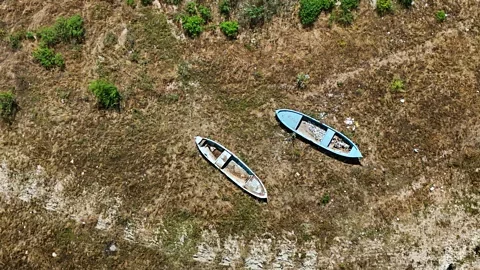
Istanbul is one of the world's biggest cities, growing larger still every year. Its rapid expansion is putting enormous stress on its water supplies.
Jodie Harburt often talks about the buzzard. In the wetlands of Şile, the town she lives in - absorbed many years ago into greater Istanbul - Harburt used to see a buzzard alight on the marshes beside the river, a small predatory wonder among the rich variety of birds and bugs and wildlife that called the river home.
The buzzard left, like an omen, when the municipality began to line the river with concrete.
"This area is supposed to be spongy, because that's where the water is supposed to stay. It's a huge water depot," says Harburt. "If you want to avoid drought situations, you have to keep the water in the soil, and you can't do that if you've lined the whole river with concrete."
The problems of one small river in Şile is a ripple out from the large problem that threatens to splash down on Istanbul: what happens if the city runs out of water?
In January 2021, the residents of Istanbul slowly, and then quickly, became inundated with ominous headlines: Istanbul could run out of water in 45 days. With reservoirs at shocking lows and little forthcoming winter rain, it was within the realm of possibility that a city of more than 15 million people might soon have no drinking water. Under the instruction of the Diyanet, Turkey's Directorate of Religious Affairs, Friday services at Istanbul's mosques included prayers for rain and water.
It wasn't the first time this has happened. Similar headlines bubble up in Istanbul's news outlets every few years. For four days in 2014, the Kadikoy neighbourhood of Istanbul had no water. At first, it was an inconvenience. In a city as large as Istanbul, water cuts occasionally happen, and residents grumble but get on and wait for the water to come back. But as the water cut extended to two days, and then three, the neighbourhood began to smell and people looked more and more frantic. By day four, there were full-blown protests as people demanded that the local government restore their water.
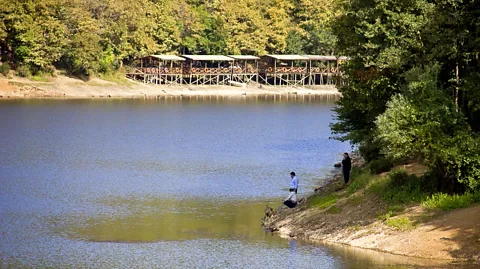
Now, the warning bells are ringing again. As recently as 4 October 2024, the reservoir levels were very low, at only 37.4% capacity. In December 2023, Agriculture and Forestry Minister İbrahim Yumaklı announced that Turkey was at risk of experiencing extreme water scarcity by 2030, and that much of the population might feel the effect of water shortages in the next six years.
Kucukcekmece Lake, an important source of water in Istanbul, is at risk of becoming polluted and running dry. Drought is at the doorstep. Day Zero, when the water runs out, is a slow-arriving disaster that is an easy one to ignore - until it arrives.
"Istanbul is already facing significant water scarcity, and we're approaching ecological limits," says Akgün İlhan, a lecturer who specialises in urban water management and its intersection with climate change at Boğaziçi University. "We need to face this reality, or we can continue to ignore it and face the consequences."
Istanbul is a city of water, hemmed in by it on all sides: the Black Sea to the north, the Sea of Marmara to the south, and the Bosphorus Strait bisecting the centre of the city itself - all salt water bodies, with no river to provide freshwater. As its status as a city of local and global importance has grown, the city has stretched out, swallowed its suburbs, and become very, very thirsty.
Water infrastructure from ancient times is still visible in the contemporary urban fabric of the city.
Always a major city, Istanbul is now a megacity, with its population ballooning in the second half of the 20th Century. In the 1950's, Istanbul had a million residents; by the 1980s, there were five million. Now, there are roughly 17 million. As the population rises, so does the demand for water; as residential areas develop on Istanbul's water basins, less water is available within the city itself.
In reaction, İSKİ, the city's water authority, has built dam infrastructure designed to bring water from villages hundreds of kilometres outside of the city into Istanbul. But when this infrastructure drains the water reservoir of these villages and damages agriculture, the residents are often forced to uproot and move - often to Istanbul, expanding its population and exacerbating the problem.
"Istanbul is fed by the whole of Turkey. It's just like sucking the blood out," says Harburt. "That's what cities do."
In a city with such a long history as Istanbul, the present and perhaps the future has echoes in the past's attempts to get water to an urban centre on the sea.
"The city thirsts," wrote the Greek philospher Themistius in the 4th Century about the city that would eventually be Istanbul: a prescient observation that continues to be true. Water infrastructure from ancient times is still visible in the contemporary urban fabric of the city. One major highway cuts directly under the Valens Aqueduct, which stretches out like a rainbow above the street and dates back to Themistius's time.
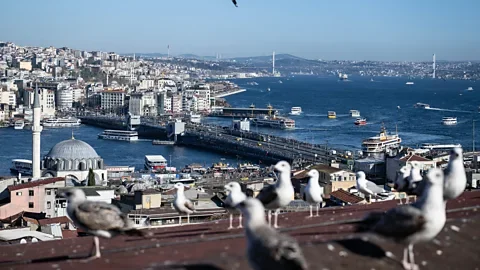
On a grey October day, Kerim Altuğ wanders through the nearly empty Binbirdirek Cistern in Sultanahmet on Istanbul's historic peninsula, whose name means "1,001 columns" but which actually only contains about 224. "They exaggerated, because [during the time of the Ottomans] it's completely dark, there is no electricity, completely dark, and when people enter they say, maybe it goes on for eternity," says Altuğ, an archaeologist and architectural historian with a focus on Byzantine water systems.
What would become Constantinople began as an ordinary Roman town within the empire. When Constantine the Great, the first Roman emperor to convert to Christianity, created the city 1,700 years ago, the population increased significantly over a short amount of time. To get water to the city, the imperial government created the longest Roman water supply line in the ancient world, including massive aqueducts from the forest west of the city. "Valens Aqueduct was the longest aqueduct system ever built in all territories of the Roman Empire," says Altuğ. "Constantinople is unique. There were probably thousands of underground cisterns built during the Byzantine period between the 5th and the 15th Century."
That history is still palpable in the modern city. There are still nearly 200 cisterns - huge vaulted caverns for storing water - that lie underneath Istanbul's historic peninsula, with many unexcavated and others, like Binbirdirek Cistern, recently restored. Istanbul's long history of managing water infrastructure for an expanding population is a portal between past and present.
Altuğ touches the pillars of Binbirdirek Cistern. "This building was built in the 5th Century, the year 400, and it's standing. Amazing! What a treasure is that. What an achievement of engineering. What an achievement of human beings' capabilities," he says.
Expanding parkland within a city can also help retain water and prevent flooding
"It's facile to say you can learn from the past, but the experience of the past can actually be very valuable in informing practices in the present, in the future. And that's different from learning from the past," says Jim Crow, an emeritus professor of Roman and Byzantine archaeology at the University of Edinburgh. Crow started working in Turkey decades ago, and became fascinated with its water infrastructure during an excavation in 1994 of the Anastasian Walls in Thrace, west of Istanbul. That dig revealed an extensive network of aqueducts hidden in the thick forest.
In 2021, Crow teamed up with İlhan and Ender Peker, an associate professor at the Middle Eastern Technical University in Ankara, Turkey, to work on a project in collaboration with the British Institute at Ankara. Together, they conducted a series of participatory action research methodology workshops with local municipalities about rainwater harvesting projects that could potentially retain more of Istanbul's water.
"The main idea was actually to look at the historical pattern of water collection systems in Istanbul and explore how it was managed in the past. So one group, mainly archaeologists and historians, were working to understand the historical pattern of water management and the other group, consisting of planners and social scientists, led by İlhan and me, focused on contemporary challenges," says Peker. "Mainly, the idea was to learn from the past experiences and somehow modify and implement it into the current condition."
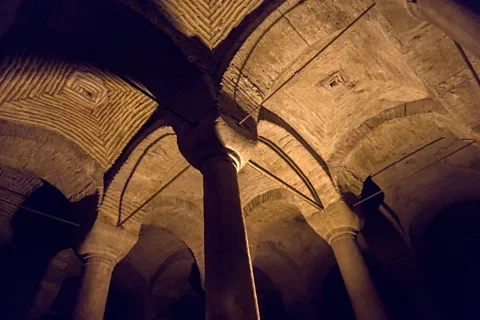
There are two main methods of rainwater harvesting: rain collected on roofs of buildings, or rain collected in large public places. Rainwater harvesting can be used to flush toilets or wash cars or irrigate gardens when collected on roofs. Larger collections can be used for Istanbul's regular street cleaning, when municipal workers come around every morning to water-blast the rubbish and dirt out of the neighbourhoods.
Recently, legislation was passed that made it compulsory for certain buildings built on specified parcel sizes to have rainwater harvesting capabilities and greywater systems. Local municipalities can also elect to make the parcel size smaller than the required size, which allows more buildings to qualify for law, though there's resistance from building developers. "It's a huge challenge, in terms of creating a governance mechanism among all those actors from different levels of authority," says Peker.
Expanding parkland within a city can also help retain water and prevent flooding. Sponge cities are designed to soak up as much of the rainwater naturally, with parks and wetlands holding on to the water. Istanbul, however, has a fraught relationship with its parks, and much of the rainwater that falls hits the extensive concrete of the dense city streets and rolls in the sea. Cities like Los Angeles and Bangkok have benefited from concerted efforts to create more sponge city infrastructure. (Read BBC Future's story on how one New Zealand city is transforming its water resources.)
It becomes difficult to manage the situation as the population keeps growing - Akgün İlhan
The effects of Istanbul's water problems are felt on the outskirts and outside of Istanbul, before they ripple to the centre. Villages near the Melen Dam are agriculturally devastated by the water infrastructure that brings drinking water hundreds of kilometres to Istanbul, and Şile's concreted rivers lead to floods locally and water seeping away from Istanbul.
"It becomes difficult to manage the situation as the population keeps growing. With more people, the demand for water rises. Local authorities feel obliged to cover this ever-growing demand. In fact, in Istanbul, even a one-day water cut could destabilise the government - that's how serious it is," says İlhan.
İSKİ, the city's water authority, was asked for comment on the current state of the city's water supplies but did not provide a statement before publication.
Peker, her partner in the water workshops, agrees. "When you absorb water like a vampire from other sources around the hinterland of the urban area, it generates really huge problems, not only water problems, but also financial and agricultural problems for the rural areas," says Peker.
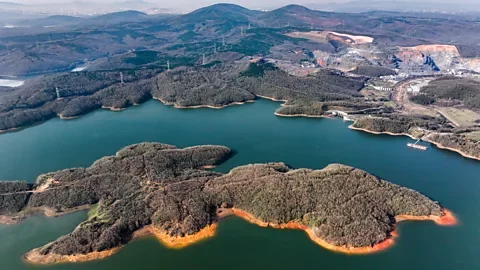
Harburt sees this firsthand in Şile, and is trying her best to address the issues locally. She and her husband Serdar started an organisation called Suda (The Sustainable Urban Development Platform), which is proposing solutions for issues related to river conservation and water management in Şile. One initiative is the Şile Oasis Project, which weds tourism, conservation and education in a "green route" along Şile's Yeni Koy River. Inspired by the Ipswich Oasis in the UK, the plan would leave a buffer zone around the banks of the river undeveloped by builders, promote ecological regeneration, and support local businesses and tourism in a sustainable manner.
In late September, Suda met the deputy mayor of Şile to present their proposals. As the overcast day's wind rattled through the windows, the deputy mayor was intrigued, but realistic about the main issue: political will. Implementing large urban infrastructure projects can be complicated in any city, but in a hugely polarised society like Turkey, every decision refracts through the funhouse mirrors of politics.
"We know we have the knowledge, we have the capacity, we have the motivation. The main challenge here is to construct this governance mechanism, because the deep political polarisation between the local authorities and the ministries is a big challenge," says Peker.
Now in Şile, as the natural reeds of the riverbed are being ripped up and covered with concrete, Jodie's buzzard looks more and more like a canary in a coal mine. It is one symptom of the complex problem of Istanbul's water.
"Climate change isn't simply about lack of water. It's about changing patterns, and how the city becomes more resilient in terms of these changing patterns," says Crow. "Looking at the past, you're aware of the complexity of the number of factors, whether the political or external pressures, rather than one single sort of determinist. What always catches the headline is: this empire died of drought... [but] it's the complexity of the past that one needs to recognise."
Harburt is going to continue to promote Suda and meet with local authorities and do her part in her small corner of Istanbul to move the needle, even a little. "Optimism isn't a word I would use about any of this," she says. "It's a determination to keep trying."


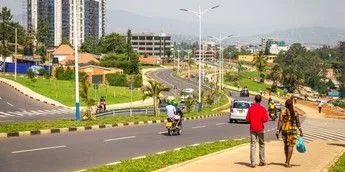

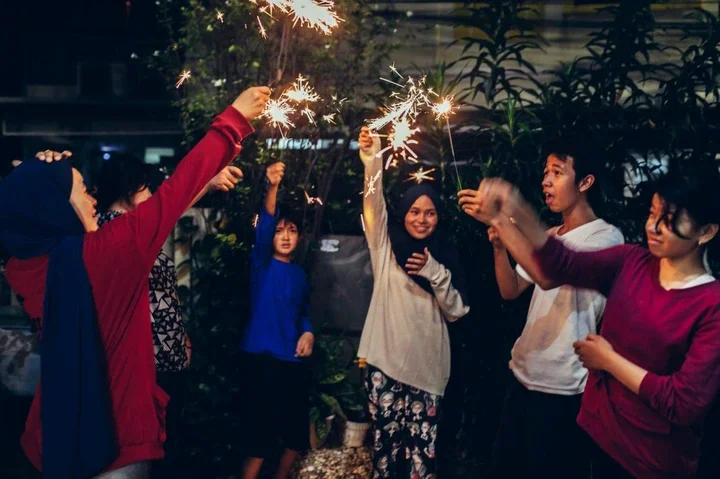











Comments